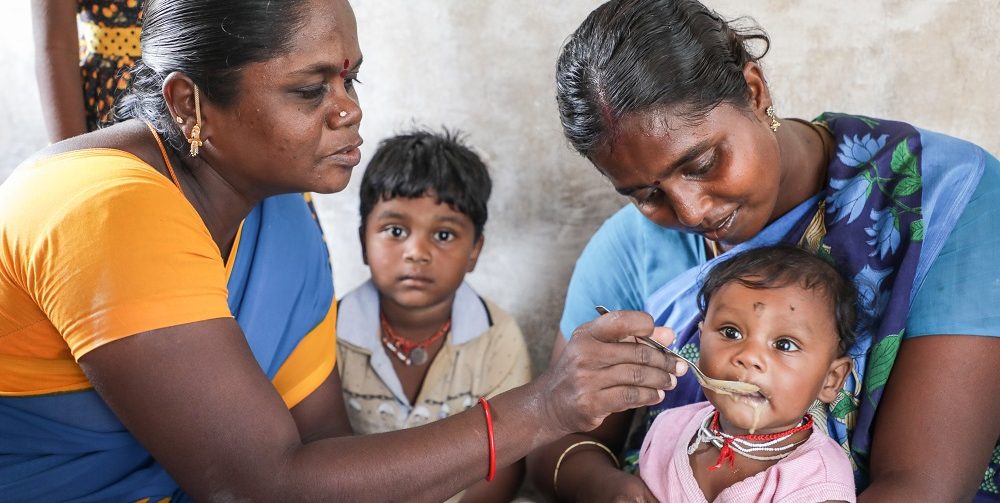
Click here to download PDF
Appropriate nutrition during early life, coming mainly from adequate infant and young child feeding (IYCF) practices, is essential for optimal growth and development. There is ample evidence to highlight associations between feeding practices and children’s growth and developmental outcomes. Despite a supportive policy environment in India for IYCF interventions, progress on IYCF is mixed and much more needs to be done - urgently - to scale up IYCF interventions in ways that reach all parents of infants and young children in India.
In this Data Note on “Feeding India’s Babies: Trends and Patterns in Infant and Young Child Feeding Practices Across India’s States and Districts” we highlight patterns and trends in how India’s babies are fed, based on data from the National Family Health Surveys III & IV (2006 & 2016). For maps in this Note district boundaries from Census 2011 were followed.
Findings of this Data Note highlight that IYCF practices in India are poor and food consumption patterns vary widely by districts and states. The Comprehensive National Nutrition Survey (CNNS) results of 2016-18 support these findings. We also find major data gaps at the district-level, which means that in several districts it is not possible to know how babies are fed. Some of the key observations and recommendations emerging from this Note are as follows:
- There was a significant improvement in breastfeeding practices between 2006 and 2016. However, data for exclusive breastfeeding was available in only about 65 percent of the total districts. Hence, there is a need to close the data gaps for exclusive breastfeeding. It is also important to promote early initiation of breastfeeding and exclusive breastfeeding through concerted behavior change communication (BCC).
- Between 2006 and 2016, there was nearly a 10‐percentage‐point decline in the timely introduction of solid or semi-solid foods. In 2016, data for children (6-8 months) who received solid/semi solid foods in a timely manner was available in less than a third of the districts (only in 179 out of 640 districts). Of these 179 districts, only in 32 districts 60 percent or more children in this age group received solid/semi solid foods in a timely manner. Hence, complementary feeding practices need special emphasis through intense BCC and accompanying interventions, such as the use of Integrated Child Development Services’ (ICDS) food supplements. Innovative approaches to close the data gaps are also needed.
- In 2016, in more than half the districts (344 out of 640 districts) only 20 percent or less children (6-23 months) were fed at least a minimum number of foods groups recommended for their age. The level of dietary diversity is a matter of concern. In 2016, only 13 percent of children (6-23 months) consumed foods from legumes & nuts group. Less than a quarter of children (24 percent) consumed other fruits and vegetables. Only 15 percent of children in this age group consumed eggs and just about 9 percent consumed flesh foods. These results underscore the need for a nation-wide campaign to increase awareness on the importance of dietary diversity.
- In 2006, less than half of children (42 percent) were fed at least as many meals as recommended for their age; in 2016 it further declined to 36 percent. Minimum acceptable diet for children was extremely low (~9 percent) and did not change much over this period. To meet the nutrition targets set by the National Nutrition Mission (or POSHAN Abhiyaan), it is essential to examine the role of Take-Home Rations, under the ICDS’ Supplementary Nutrition Program, in relation to the overall feeding patterns. It is also essential to improve policy guidance, policy coordination and monitoring of existing programs on food supplementation and fortification.
- Between 2006 and 2016, consumption of iron-rich foods among children remained stagnant at around 20 percent. In 2016, out of 640 districts, in only 36 districts 60 percent or more children (6-23 months) consumed iron-rich foods. Iron deficiency is an important cause of anemia and it is widely prevalent among 1-4-year-old children (CNNS 2016-18). To encourage the consumption of iron-rich foods, it is important to generate awareness about the health benefits of an iron-rich diet, its sources, and the significance of adding a source of vitamin C to enhance iron absorption. There is also a need to improve the availability of data on outcomes and determinants of iron deficiency, and their relation to food consumption patterns.
Every year 27 million babies are born in India. Nourishing them adequately is paramount for meeting the targets set by POSHAN Abhiyaan and the nutrition-related Sustainable Development Goals. To know more about how India’s babies are fed, by state and by district, take a look at our Data Note on “Feeding India’s Babies: Trends and Patterns in Infant and Young Child Feeding Practices Across India’s States and Districts”.


